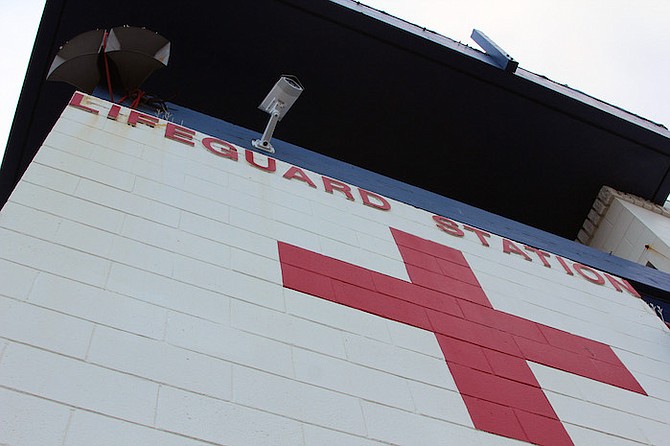 Facebook
Facebook
 X
X
 Instagram
Instagram
 TikTok
TikTok
 Youtube
Youtube

After months of contention over the use of surveillance cameras along the Ocean Beach coastline, it’s all over except for the signage.
The first three cameras — in all, ten are planned — appeared recently on the walls of the community’s lifeguard tower on Abbott Street. All cameras will be accompanied by signs that warn of continuous recording, according to Conrad Wear, representative to District 2 San Diego city councilwoman Lorie Zapf.
No recording may take place before signs have been posted, Wear said.
Though the installation of the cameras appears to be a foregone conclusion, there’s some debate about what the signs should look like. Wear asked members of the Ocean Beach Planning Board last month for feedback. Two emailed back, and those comments have been relayed to city graphic designers, Wear said.
Some community members have called for softening up the signs with friendly beach images such as a seagull in flight or logos of community groups. Wear said he met with city staff last week to obtain sketches and would show them to the planning board before production.
“We definitely want to be upfront and transparent, but we don’t want [the signs] to look so Big-Brotherish,” Wear told planning-board members last month. “If we can make them more O.B.-ish, we will.”
The signs must be approved by the city attorney to ensure compliance with legal requirements, such as the Americans with Disabilities Act, Wear said.
Rick Callejon of Ocean Beach formed Citizens Against Privacy Abuse late last year to protest the cameras. Contacted by phone, he chuckled ironically at the notion of asking the community to help design the signs, but not reaching out when deciding whether to install the cameras in the first place.
Callejon doubted any amount of dressing up would make the cameras appear less oppressive.
“You go to the beach and first thing you see is, ‘You are under video surveillance.’ What kind of message does that send?” he asked.
Callejon said police have not adequately addressed concerns his group has raised over the past several months. Among them: the lack of a plan to evaluate the efficacy of the program, the likelihood of crime to migrate away from camera view, privacy concerns, and potential for abuses.
He’s also concerned the cameras could invite vandalism. “I don’t condone this, but you do hear things,” Callejon said.
Police say recordings will be used two ways: to provide footage for investigating crimes after they’ve been reported and, less frequently, record sting operations to catch drug-related and other criminals. In addition, the high-visibility nature of the cameras will deter crime, police say.
Callejon said he’s resigned to the installation of the cameras for now but noted funding is not guaranteed beyond one year. “We’ll have to wait and see,” he said.


After months of contention over the use of surveillance cameras along the Ocean Beach coastline, it’s all over except for the signage.
The first three cameras — in all, ten are planned — appeared recently on the walls of the community’s lifeguard tower on Abbott Street. All cameras will be accompanied by signs that warn of continuous recording, according to Conrad Wear, representative to District 2 San Diego city councilwoman Lorie Zapf.
No recording may take place before signs have been posted, Wear said.
Though the installation of the cameras appears to be a foregone conclusion, there’s some debate about what the signs should look like. Wear asked members of the Ocean Beach Planning Board last month for feedback. Two emailed back, and those comments have been relayed to city graphic designers, Wear said.
Some community members have called for softening up the signs with friendly beach images such as a seagull in flight or logos of community groups. Wear said he met with city staff last week to obtain sketches and would show them to the planning board before production.
“We definitely want to be upfront and transparent, but we don’t want [the signs] to look so Big-Brotherish,” Wear told planning-board members last month. “If we can make them more O.B.-ish, we will.”
The signs must be approved by the city attorney to ensure compliance with legal requirements, such as the Americans with Disabilities Act, Wear said.
Rick Callejon of Ocean Beach formed Citizens Against Privacy Abuse late last year to protest the cameras. Contacted by phone, he chuckled ironically at the notion of asking the community to help design the signs, but not reaching out when deciding whether to install the cameras in the first place.
Callejon doubted any amount of dressing up would make the cameras appear less oppressive.
“You go to the beach and first thing you see is, ‘You are under video surveillance.’ What kind of message does that send?” he asked.
Callejon said police have not adequately addressed concerns his group has raised over the past several months. Among them: the lack of a plan to evaluate the efficacy of the program, the likelihood of crime to migrate away from camera view, privacy concerns, and potential for abuses.
He’s also concerned the cameras could invite vandalism. “I don’t condone this, but you do hear things,” Callejon said.
Police say recordings will be used two ways: to provide footage for investigating crimes after they’ve been reported and, less frequently, record sting operations to catch drug-related and other criminals. In addition, the high-visibility nature of the cameras will deter crime, police say.
Callejon said he’s resigned to the installation of the cameras for now but noted funding is not guaranteed beyond one year. “We’ll have to wait and see,” he said.
Comments